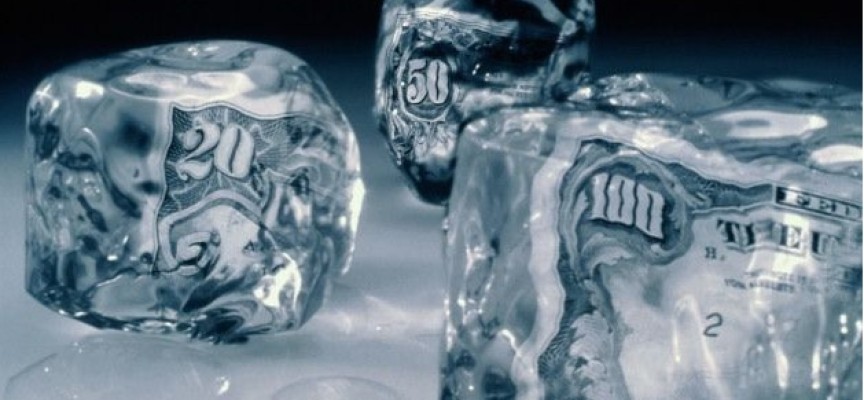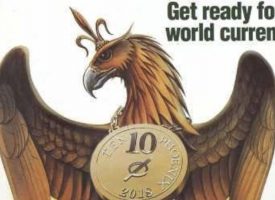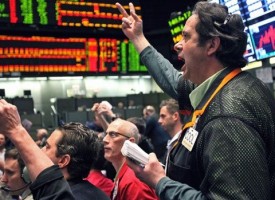With the dollar tumbling, gold and silver surging and the mining share indexes hitting new multi-year highs, the world may not see a total collapse of global currencies but here is what will get destroyed.
By Bill Fleckenstein President Of Fleckenstein Capital
August 2 (King World News) – The August doldrums potentially ended after just one day with overnight markets actually providing a little excitement. Turning first to world bond markets, Japanese government bonds were roughed up on a percentage basis, as yields rose from -14 basis points to only -8.5 (recall it was only about a week ago when the “high” was set at -30 bps). All of Europe lost a similar amount of “bips,” which is no big deal in absolute terms, but in percentage terms at current levels amounted to pretty chunky losses. The apparent catalyst for the selloff in Japan was the fact that the government stimulus program was less than expected…
Continue reading the Bill Fleckenstein piece below…
Advertisement
To hear which company investors & institutions around the globe are flocking to
that has one of the best gold & silver purchase & storage platforms
in the world click on the logo:

Well, You Could Have Banked On It
Turning to equity markets, Japan lost about 1.5%, China was closed, and European markets lost a couple of percent as they were led lower by continued horrendous action in bank stocks there following the latest round of stress tests. One of the few things that we did right in America post the financial crisis was make banks raise enough capital to (maybe) weather the next downturn, while Europe did not, thus the latter’s financial institutions remain more vulnerable than ours.
With all that red ink around the world it was not shocking to see the SPOOs start a little lower, but in a departure from recent trends, they continued that course, with the market losing 1% through mid-afternoon. They bounced from there and with an hour to go (when I had to leave) were about 0.75% lower. Away from stocks, the net effect of the financial market machinations in Japan led to a more than 1% yen rally, as that currency closed at a new high versus the dollar for this particular move. Green paper was weak against most other pieces of colored paper and the dollar index continues to look to me like it is making a two-year-long top, which is not so different from what the S&P has been building, despite the recent new highs in the averages.
Turning to fixed income — and this was the most interesting development today, though it is only one day — bonds sank with stocks, as they did the world over. Again, this is only one session, but if this were to persist it would be very meaningful. (I think it is still too early for that sort of repudiation of the bond market on the part of fixed income investors, but who knows.) Oil lost 1% and the precious metals gained nearly 1%.
QE and A
Now I’d like to turn to the subject of QE. Today’s Financial Times carried a really wonderful and succinct article explaining why such policies haven’t worked and that the central banks are trapped. Written by Satyajit Das and headlined, “QE-forever cycle of fiscal stimulus won’t generate any recovery” (online: “QE-forever cycle will have an unhappy ending”), the article begins:
“Policymakers have chosen to ignore the central issue of debt as they try to resuscitate activity.
“Since 2008, total public and private debt in major economies has increased by over $60tn to more than $200tn, about 300 per cent of global gross domestic product (‘GDP’), an increase of more than 20 percentage points…
“If the average interest rate is 2 per cent, then a 300 per cent debt-to-GDP ratio means that the economy needs to grow at a nominal rate of 6 per cent to cover interest.”
Owe No!
Just reread those sentences to see what a horrendous predicament “policymakers” have created for themselves — and us. He goes on to write:
“Policy normalisation is difficult because higher interest rates would create problems for over-extended borrowers and inflict losses on bond holders. Debt also decreases flexibility and resilience, making economies vulnerable to shocks.
“Attempts to increase growth and inflation to manage borrowing levels have had limited success. The recovery has been muted.”
Forgive and Forget
Das goes on to discuss said “recovery” before delivering some hard truths:
“In the absence of growth and inflation, the only real alternative is debt forgiveness or default [emphasis mine]. Savings designed to finance future needs, such as retirement, are lost…
“Unable to grow, inflate, default or restructure their way out of debt, policymakers are trying to reduce borrowings by stealth. Official rates are below the true inflation rate to allow over-indebted borrowers to maintain unsustainably high levels of debt…
“Debt monetisation and artificially suppressed or negative interest rates are a de facto tax on holders of money and sovereign debt. It redistributes wealth over time from savers to borrowers and to the issuer of the currency, feeding social and political discontent as the Great Depression highlights.”
Paging Admiral Ackbar
He then lays out the “trap:”
“If the economy responds [to all the stimulus], then the side effects of QE encourage a withdrawal of the stimulus. Higher interest rates slow the economy and trigger financial crises, setting off a new round of the cycle.
“If the economy does not respond or external shocks occur, then there is pressure for additional stimuli, as policymakers seek to maintain control.”
Sound familiar? He sums up by citing Ludwig von Mises’ assessment of these sorts of policies, who predicted that the only “choice” policymakers will have is, “‘…whether the crisis should come sooner as a result of a voluntary abandonment of further credit expansion, or later as a final and total catastrophe of the currency system involved.’”
Out of Many, One Boat
So there you have it. The vicious cycle that we have been involved in continues, although in my opinion it will end not necessarily with a collapse of currencies, but a breaking of the world’s bond markets. We would more likely see a currency collapse if only one country were pursuing these policies. When they are all doing it, a bond market collapse is more likely.
The point is, this article is a nice, tight explanation of why these policies don’t work and where we are headed, with some mind-boggling data points, e.g., debt outstanding versus GDP and what that means in terms of interest costs should rates ever rise as the bond markets take the printing press away from the central banks.
Included below are three questions and answers from the Q&A’s with Bill Fleckenstein.
Bonus Q&A
Question: Hi Fleck, what do you think will happen to gold when the bond market crashes?
Answer from Fleck: “Let’s not get so far ahead of ourselves, you are several moves in advance. The bond market losing confidence in the Fed should be bullish for gold, and bond market weakness will take some time to develop into real trouble. At this point, talking about a crash is very premature, IMO.”
Question: Hi Fleck, I am starting to wonder if all these highs in bond and equity (US) markets, are suggesting that markets are sniffing out the potential damage that is being (self) inflicted on fiat currencies. That is, everything is denominated in something, and if the $ or £ or whatever, is vulnerable and decaying, then the underlying asset can appreciate in those terms. Probably not the main factor at the moment, admittedly, and obviously gushing liquidity usually ends up in asset prices anyway, but just a thought.
Answer from Fleck: “Could be, but if they really thought that way, gold would be much higher and bonds would be weaker, I think.”
Question: Bill: In December 2015 I wrote the following:
“The coyote-like plummet in gold starting in 2011 has slowed to trickle, which has prompted me to spend approximately 20% of my gross salary on physical gold this year (my first purchases since my 1999–2005 binge.) Of course, the gold miners are priced like pillows at a thrift store, and investors are plastered across milk cartons. Maybe this is a bottom, but the inability of management to make money is epic. Harmony Gold is trading at 16% book value, but such numbers are often the costs of assets purchased in haste that have not yet been written down. Rumors of corporate insider buying in the industry in a profoundly beaten-down sector is arguably bullish, but I am leaving the gold equity “buying opportunity of a lifetime” to others; my shrunken stash of equities is it for now. Maybe I just called the bottom.”
140% spike later on the XAU I think you and your readers owe me a big hug for the self-sacrifice required to set the bottom with my recklessly painful inaction. One of us had to play the fool. You’re all welcome. Not to worry, however; I’m sure I will be offered many more opportunities to miss in the future.
Answer from Fleck: Thanks for taking one for the team, we do appreciate it. 🙂
***To subscribe to Bill Fleckenstein’s fascinating Daily Thoughts CLICK HERE.
To hear more about the gold and silver markets, listen to the jaw-dropping audio interview with Michael Belkin, the man who advises the most prominent sovereign wealth funds, pension funds, hedge funds, and institutional funds in the world discussing the historic run in the gold & silver markets, what to expect next for gold, silver and the shares and much more by CLICKING HERE OR ON THE IMAGE BELOW.
© 2016 by King World News®. All Rights Reserved. This material may not be published, broadcast, rewritten, or redistributed. However, linking directly to the articles is permitted and encouraged.









